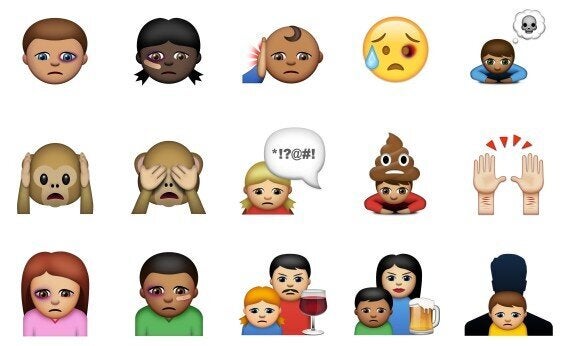A Swedish children's charity have created a set of emojis to help young victims who are struggling to communicate their problems through words.
'Abused Emojis' feature a range of emoticons from a small boy with a black eye to a girl being loomed over by her angry, drunk father.
The free app was created by Swedish charity BRIS (Children's Rights in Society) which helps vulnerable children and teenagers, by running a national helpline much like NSPCC's Childline in the UK.

A handful of emojis on the app
"Some things are hard to spell out. Abused Emojis will make it easier for kids to talk to others about negative feelings or about situations where they have been treated wrong," says the charity.
"Many of the problems that kids face today are stigmatised and often they have no one to talk to but us. A complex reality demands a complex set of symbols. Abused Emojis is part of our work to let children talk more freely about their situation."
The app follows recent news that emoji has become the fastest-growing language with 80% of people are using emojis to communicate.
An NSPCC spokesman welcomed the app and told HuffPost UK Lifestyle: "Emojis have become a huge part of young people’s lives and a popular way for young people to quickly express their feelings. When young people struggle to find the right words to express themselves an emoji may help bridge that gap, or even be a first step to talking about their problems."
Donna Chadwick, team leader for The Children’s Society’s emotional health and wellbeing service in Greater Manchester, said: "I have seen a lot of children use standard emojis, for example on Facebook, where the faces are crying or angry. These new emojis could be very useful to a child who might have difficulty talking truthfully about what’s going on in their life.
"Children have a limited number of words in their vocabulary and so this could be a good tool for them to start telling their story. A picture is worth a thousand words."
But while The Children’s Society welcomes new and innovative ways for children to be heard and talk about their stories, the organisation stress the importance of using a range of methods to access children.
"Not all children will have access to smartphones, we need to keep thinking about the children who are hidden and the most hard to reach and engage," the spokesperson added.
There are a few potential issues with the app however. Once downloaded users need to add the keyboard to settings, but the app has to remain on the phone to access the keyboard.
If the app is found by the abuser, it could be potentially "very dangerous" for the victim. The icon, which is an image of a boy with a black eye, is hardly discreet.
Speaking to HuffPost UK Lifestyle, Hilary Fisher, director of Policy, Voice and Membership at Women's Aid, said: "For a child or young person living in a violent household, the app could be useful for them to communicate what is happening at home. However, it could also pose a serious risk as it is likely that their phones will be monitored.
"For victims of domestic violence, the app does not necessarily provide a safe way for them to communicate their abuse as it assumes that the victim is the only one accessing the phone. This is not the case due to coercive control, which is at the heart of domestic violence. A typical element of coercive control is for the perpetrator to monitor a victim’s phone, therefore they are likely to see an ‘abused emoji’ being used in a message. This could potentially be very dangerous for the victim."